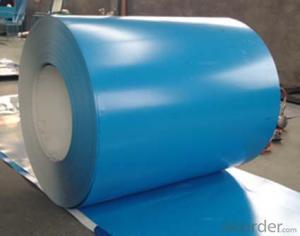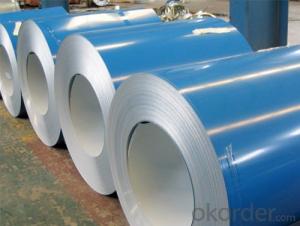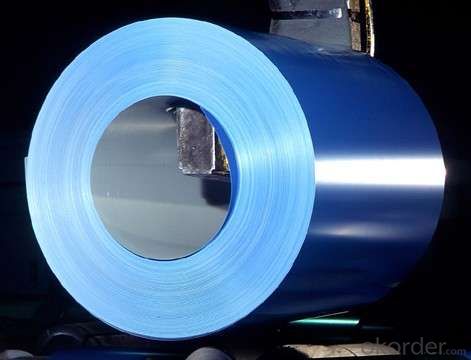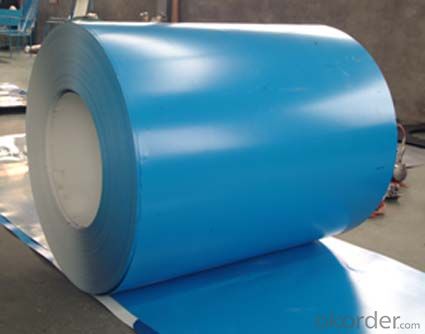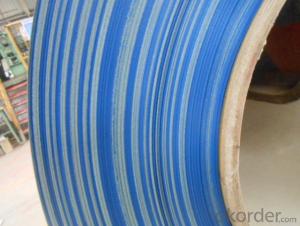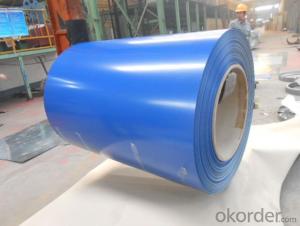Pre-Painted Galvanized Steel Coil with High Quality Blue Color
- Loading Port:
- Shanghai
- Payment Terms:
- TT OR LC
- Min Order Qty:
- 100 m.t.
- Supply Capability:
- 10000 m.t./month
OKorder Service Pledge
OKorder Financial Service
You Might Also Like
1. Pre-Painted Galvanized/Aluzinc Steel Coil Description:
With GI as base material, after pretreatment (degrease and chemical treatment ) and liquid dope with several layers of color, then after firing and cooling, finally the plate steel is called pre-painted galvanized (aluzinc) steel. Pre-painted galvanized steel is good capable of decoration, molding, corrosion resistance. It generally displays superior workability, durability and weather resistance.
2.Main Features of the Pre-Painted Galvanized/Aluzinc Steel Coil:
• Excellent process capability
• Smooth and flat surface
• Workability, durability
• Excellent heat resistance performance
• High strength
• Good formability
• Good visual effect
3.Pre-Painted Galvanized/Aluzinc Steel Coil Images

4.Pre-Painted Galvanized/Aluzinc Steel Coil Specification
Standard: AISI, ASTM, BS, DIN, GB, JIS
Grade: DX51D, DX52D
Thickness: 0.17-2.0mm
Brand Name: KMRLON
Model Number: coil
Type: Steel Coil
Technique: Cold Rolled
Surface Treatment: Coated
Application: Boiler Plate
Special Use: High-strength Steel Plate
Width: 20-1250mm
Length: customized
commoidty: pre-painted galvanized steel coil
Thickness: 0.13-4.0mm
width: 20-1250mm
zinc coating: 40-180g/m2
printing thickness: top side: 20+/-5 microns, back side: 5-7 microns
color: all RAL color
surface treatment: color coated
coil weight: 4-7 tons
coil ID: 508/610mm
packaging: standard seaworthy packing
5.FAQ of Pre-Painted Galvanized/Aluzinc Steel Coil
1. What’s the application of this product?
Roof, roof structure, surface sheet of balcony, frame of window, etc.
2. What’s the brand of the paint?
We use the best brand of all of the word—AKZO.
3. How to guarantee the quality of the products?
We have established the international advanced quality management system,every link from raw material to final product we have strict quality test;We resolutely put an end to unqualified products flowing into the market. At the same time, we will provide necessary follow-up service assurance.
4. How long can we receive the product after purchase?
Usually within thirty working days after receiving buyer’s advance payment or LC. We will arrange the factory manufacturing as soon as possible. The cargo readiness usually takes 15-25 days, but the shipment will depend on the vessel situation.
- Q: What are the advantages of using galvanized steel coils?
- There are several advantages to using galvanized steel coils. Firstly, galvanized steel is highly resistant to corrosion, which means it can withstand exposure to moisture and other harsh environmental conditions without rusting. This makes it a durable and long-lasting material for various applications. Secondly, galvanized steel coils have a protective zinc coating that acts as a barrier against damage and provides excellent structural strength. Additionally, galvanized steel coils are versatile and can be easily formed, welded, and painted, making them suitable for a wide range of industries and projects.
- Q: How are steel coils used in the production of electrical conduits?
- Steel coils are used in the production of electrical conduits as they serve as the raw material for manufacturing these conduits. The steel coils are processed and shaped into cylindrical tubes, which are then used to protect and enclose electrical wires, ensuring safe and efficient transmission of electricity.
- Q: What is the average turnaround time for processing steel coils?
- The average turnaround time for processing steel coils can vary depending on several factors such as the size and complexity of the coils, the specific processing requirements, and the efficiency of the manufacturing facility. However, in general, the average turnaround time for processing steel coils can range from a few days to a couple of weeks.
- Q: How are steel coils cut and shaped for specific requirements?
- Steel coils are cut and shaped for specific requirements through a process called slitting and forming. Slitting involves cutting the coil into narrower strips using specialized machinery, while forming utilizes presses, rollers, or other tools to shape the steel into desired profiles. These processes allow manufacturers to tailor the dimensions and shape of the steel coils to meet specific industry and customer requirements.
- Q: Which type is better and give reasons why... I making a team of either Dark or Steel :D Thankyou
- Dark Steel Pokemon
- Q: hello, I am trying to figure out what wok to get and came across a website that offers many woks out of different materials. what is the best, or considered original (traditional)? I have a couple of cast iron pots and pans - too heavy, so I am assuming it will take some time for a cast iron wok to heat up. what about carbon steel and stainless steel? Thanks
- 1. Do not buy stainless Steel wok. Stainless steel is a poor conductor of heat. 2. Cast iron is traditional. It is heavy and takes long to heat and cool. You can get used to heating cooling, but weight can be a problem. I would not buy cast iron. 3. You may not believe this but carbon steel is also traditional and most widely used wok. Normally, a good wok is pounded out of high carbon steel thick stock. The pounding leaves thick bottom and gradually thinner walls. It is a good conductor of heat, easy to heat and cool, and light weight to mange taking off the heat when needed. I recommend buying high carbon steel wok
- Q: I'm kind of confused as to how the difference between a stainless steel and blued steel firearm is sometimes only $20 or so. Isn't stainless steel fairly more expensive to manufacture than plain carbon steel? Are some stainless steel firearms simply stainless steel finished with carbon steel underneath?
- I don't know that stainless can be laminated to steel very easily. Stainless is a little more expensive. The problem comes in that stainless is much harder to machine that normal gun steel. With laminated steel, you would still have the problem of machining the stainless. Occasionally firearms are nickle plated or barrels are chrome lined.
- Q: So I was thinking about doing corset waist training and I wanted to know where I can get a real steel boned corset?
- Hi, okorder / There are 3 types of corsets: Fashion corsets, Authentic corsets and Waist training corsets. The fashion corsets are designed for light enclasping of body. They are made with plastics bones usually. The authentic corsets can reduce your waist size about 4 - 5 and the waist training corsets about 6. They both are made with steel spirals and flat bones. The waist training corsets are recommended for experienced wearers only. Look on info pages of the seller. The corsets reinforced with plastic bones are cheap with low durability.
- Q: How are steel coils used in the production of metal bridges?
- Due to their versatility, strength, and durability, steel coils are a crucial element in the manufacturing of metal bridges. These coils, typically made from high-quality steel alloys, provide the necessary structural integrity required for bridge construction. To begin the process of using steel coils for bridge production, they undergo a series of manufacturing techniques. The coils are uncoiled and straightened to eliminate any distortions or bends. They are then precisely cut into lengths according to the specifications of the bridge design. Once the steel coils have been processed, they are transformed into various structural components used in bridge construction. These components include beams, girders, trusses, and plates. Beams and girders serve as the primary support structure of the bridge, while trusses provide additional support and stability. Plates are used for the bridge deck, providing a surface for vehicles and pedestrians to travel on. Steel coils also play a critical role in the fabrication of bridge connections and joints. These connections are essential for transmitting loads and forces throughout the bridge structure, ensuring its stability and safety. Steel coils are utilized in the creation of various connection elements, such as bolts, nuts, washers, and welded sections. Furthermore, steel coils are commonly employed in the production of bridge reinforcements. Rebar, which is used to strengthen concrete elements within the bridge, is manufactured from steel coils. By enhancing the load-bearing capacity and resistance to bending and tension, these reinforcements strengthen columns, piers, and abutments. In addition to their structural applications, steel coils are also utilized for protective coatings on metal bridges. They can be coated with specialized materials like zinc, epoxy, or paint to prevent corrosion and extend the bridge's lifespan. These coatings are especially important in harsh environments with high levels of moisture, chemicals, and weathering factors, as they help maintain the bridge's structural integrity. Overall, steel coils are the foundation of metal bridge production. They are transformed into various components, connections, reinforcements, and protective coatings that ensure the bridge's strength, durability, and longevity.
- Q: Its big and expensive and i don't know if it would have a logical purpose but its sharp as hell and awesome. Anyways, its made from surgical steel and all i have found on the internet is that its probably 316L (w/e that means). I have another knife made from 440 stainless steel and as far as i know that is pretty much the hardest stainless metal. So why would the more expensive one be made from surgical steel?
- Surgical Steel Knives
Send your message to us
Pre-Painted Galvanized Steel Coil with High Quality Blue Color
- Loading Port:
- Shanghai
- Payment Terms:
- TT OR LC
- Min Order Qty:
- 100 m.t.
- Supply Capability:
- 10000 m.t./month
OKorder Service Pledge
OKorder Financial Service
Similar products
Hot products
Hot Searches
Related keywords

